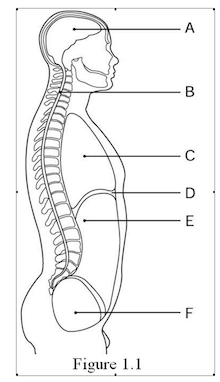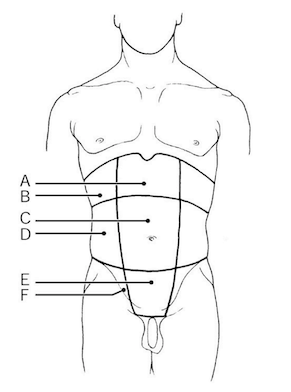
Identify the cavity that houses the spinal cord. A) Label A
B) Label B
C) Label C
D) Label D
B

Label A points to the ________ cavity.
A) thoracic
B) pelvic
C) cranial
D) abdominal
C
Identify the cavity that houses the heart and lungs (and other organs).
A) Label A
B) Label E
C) Label C
D) Label F
...

Identify the structure that separates the thoracic cavity from the rest of the ventral cavity.
A) Label A
B) Label B
C) Label C
D) Label D
E) Label E
F) Label F
D

Label F points to the ________ cavity.
A) thoracic
B) pelvic
C) cranial
D) abdominal
B
Identify the cavity that houses the stomach, liver, and other digestive organs.
A) Label A
B) Label B
C) Label C
D) Label D
E) Label E
F) Label F
E
A structure composed of two or more tissue types that performs a specific function for the body is a(n) ________.
A) organ
B) tissue
C) cell
D) organ system
A
The heart and blood vessels are the primary organs of the ________ system.
A) lymphatic
B) integumentary
C) cardiovascular
D) muscular
C
The skeletal muscles that contract and shorten to move the bones form the ________ system.
A) skeletal
B) muscular
C) endocrine
D) reproductive
B
The ________ system rids the body of indigestible food residue in feces while the ________ system removes nitrogen-containing metabolic waste in urine.
A) urinary; digestive
B) cardiovascular; urinary
C) digestive; urinary
D) reproductive; digestive
C
________ refers to all of the chemical reactions in the body.
A) Metabolism
B) Homeostasis
C) Hematopoiesis
D) Irritability
A
Normal human body temperature is ________° C (or ________° F).
A) 37; 98
B) 100; 212
C) 98; 37
D) 72; 102
A
The component of a control system that provides the means for the control center's response (output) is called the ________.
A) stimulus
B) effector
C) receptor
D) control center
B
The net effect of the effector is to shut off the original ________, or reduce its intensity, during the negative feedback mechanism to restore homeostasis.
A) response
B) receptor
C) control center
D) stimulus
D
When we imagine a person exhibiting anatomical position, the palms of the hands are assumed to be facing ________.
A) to the side
B) forward
C) down
D) behind
B
The body's ability to maintain stable internal conditions is referred to as ________.
A) metabolism
B) homeostasis
C) irritability
D) output
B
The femoral region is ________ to the crural region.
A) superior (proximal)
B) inferior (distal)
C) anterior
D) lateral
A
The armpit area is called the ________ region.
A) brachial
B) antebrachial
C) axillary
D) femoral
C
The vertebral region is ________ to the sternal region.
A) lateral
B) dorsal (posterior)
C) ventral (anterior
D) medial
B
The central region of the thoracic cavity containing the heart is called the ________.
A) pleural cavity
B) mediastinum
C) quadrant
D) visceral cavity
B
The right and left iliac (inguinal) regions are lateral to the ________ region.
A) hypogastric (pubic)
B) right hypochondriac
C) right lumbar
D) left hypochondriac
A
The cranial and spinal cavities are subdivisions of the ________ cavity.
A) ventral
B) abdominopelvic
C) thoracic
D) dorsal
D
The diaphragm creates a ________ section between the thoracic and abdominal body cavities.
A) transverse (cross)
B) median
C) midsagittal
D) frontal (coronal)
A
The hypogastric (pubic) region is ________ to the umbilical region.
A) superior
B) inferior
C) posterior
D) medial
B
Ventral is a directional term synonymous with ________ in humans.
A) posterior
B) dorsal
C) anterior
D) medial
C
Which region is medial?
A) right hypochondriac region
B) epigastric region
C) right lumbar region
D) left lumbar region
B
The navel is located in the ________ region of the abdominopelvic cavity.
A) epigastric
B) hypogastric
C) umbilical
D) right lumbar
C
The two major body cavities are ________ and ________.
A) abdominopelvic; thoracic
B) ventral; dorsal
C) cranial; dorsal
D) thoracic; ventral
B
The abdominopelvic and thoracic cavities are subdivisions of the ________ cavity.
A) superior
B) ventral
C) dorsal
D) pelvic
B
The orbital cavities house the ________.
A) mouth
B) nose
C) eyes
D) ears
C
The abdominopelvic cavity has ________ quadrants and ________ regions.
A) 6; 10
B) 9; 4
C) 4; 2
D) 4; 9
D
The majority of the liver and the gallbladder are situated in the ________ region of the abdominopelvic cavity.
A) right lumbar
B) left hypochondriac
C) right hypochondriac
D) right iliac (inguinal)
C
The epigastric region is ________ to the right hypochondriac region of the abdominopelvic cavity.
A) medial
B) superior
C) dorsal
D) lateral
A

In which region is the stomach located?
A) Label A B) Label B
C) Label C
D) Label D
E) Label E
F) Label F
A

Which region is the umbilical region?
A) Label A
B) Label B
C) Label C
D) Label D
E) Label E
F) Label F
C

Which region is lateral to the umbilical region?
A) Label A
B) Label B
C) Label C
D) Label D
E) Label E
F) Label F
D

Which region is associated with the lower ribs? A) Label A
B) Label B
C) Label C
D) Label D
E) Label E
F) Label F
B

The hypogastric (pubic) region is:
A) Label A
B) Label B
C) Label C
D) Label D
E) Label E
F) Label F
E

Which region is situated inferior to the right lumbar region?
A) Label A
B) Label B
C) Label C
D) Label D
E) Label E
F) Label F
F
The study of the structure and shape of the body and its parts and their relationships to one another is called ________.
A) anatomy
B) physiology
C) homeostasis
D) negative feedback
E) irritability
A
Which of the following activities represents a physiological study?
A) making a section through the kidney to observe its interior
B) examining the surface of a bone
C) viewing muscle tissue through a microscope
D) studying how the layers of the skin are organized
E) observing how the heart contracts to pump blood
E
Which of the following is the correct sequence, going from simplest to most complex, in the levels of structural organization of the human body?
A) chemical level, cellular level, tissue level, organ level, organ system level, organismal level
B) chemical level, tissue level, cellular level, organ system level, organ level, organismal level
C) cellular level, chemical level, tissue level, organ level, organ system level, organismal level
D) cellular level, tissue level, chemical level, organ level, organ system level, organismal level
E) cellular level, chemical level, tissue level, organ system level, organismal level, organ level
A
The building blocks of ALL matter are known as ________.
A) organs
B) tissues
C) atoms
D) cells
E) organ systems
C
The major organs of the cardiovascular system are the ________.
A) skeletal muscles
B) pharynx, larynx, trachea, bronchi and lungs
C) bones, cartilages, ligaments, and joints
D) brain, spinal cord, nerves, sensory receptors
E) heart and blood vessels
E
The main function of the respiratory system is to ________.
A) transport oxygen, nutrients, and wastes to and from body cells and tissues
B) produce sperm and eggs
C) supply the body with oxygen and remove carbon dioxide
D) control body activities through hormones released into the blood
E) break down food and deliver the products to the blood for dispersal
C
The system that controls and coordinates the body through hormones is the ________.
A) integumentary system
B) skeletal system
C) nervous system
D) endocrine system
E) digestive system
D
The muscular system consists of the ________.
A) skeletal muscles
B) muscles of the heart
C) muscles in the walls of hollow organs
D) skeletal muscles and the muscles of the heart
E) muscles of the heart and those in the walls of the hollow organs
A
Which two organ systems include the pancreas? A) digestive and endocrine systems
B) urinary and respiratory systems
C) reproductive and urinary systems
D) digestive and respiratory systems
E) endocrine and respiratory systems
A
Which system covers the external surface of the body and protects deeper tissues?
A) endocrine system
B) integumentary system
C) nervous system
D) lymphatic system
E) skeletal system
B
What is the major function of the lymphatic system?
A) return leaked fluids back to the cardiovascular system
B) produce offspring
C) eliminate nitrogen-containing metabolic wastes from the body
D) break down food into absorbable units
E) secrete hormones to regulate body processes such as growth and reproduction
A
What are two organ systems that are involved in the excretion of wastes from the body?
A) digestive and urinary
B) cardiovascular and skeletal
C) muscular and skeletal
D) endocrine and nervous
E) cardiovascular and nervous
A
Which of the following systems is matched most accurately to the life function it provides?
A) integumentary system - movement
B) nervous system - excretion
C) muscular system - maintaining boundaries
D) nervous system - responsiveness
E) respiratory system - digestion
D
Which survival need accounts for 60 to 80 percent of body weight?
A) nutrients
B) oxygen
C) water
D) minerals
E) vitamins
C
Which of the following is the correct order of elements in a control system?
A) receptor, stimulus, afferent pathway, control center, efferent pathway, effector, response
B) receptor, stimulus, efferent pathway, control center, afferent pathway, effector, response
C) effector, stimulus, efferent pathway, control center, afferent pathway, receptor, response
D) stimulus, receptor, afferent pathway, control center, efferent pathway, effector, response
E) stimulus, receptor, efferent pathway, control center, afferent pathway, effector, response
D
Which of the following elements of a control system detects a change?
A) control center
B) stimulus
C) effector
D) receptor
E) efferent pathway
D
Positive feedback systems ________.
A) involve blood clotting and the birthing of a baby
B) operate in such a way that the initial stimulus is enhanced and increases
C) operate in such a way that the initial stimulus is shut off or reduced
D) involve blood clotting and the birthing of a baby, and operate in such a way that the initial stimulus is enhanced and increases
E) involve blood clotting and the birthing of a baby, and operate in such a way that the initial stimulus is shut off or reduced
D